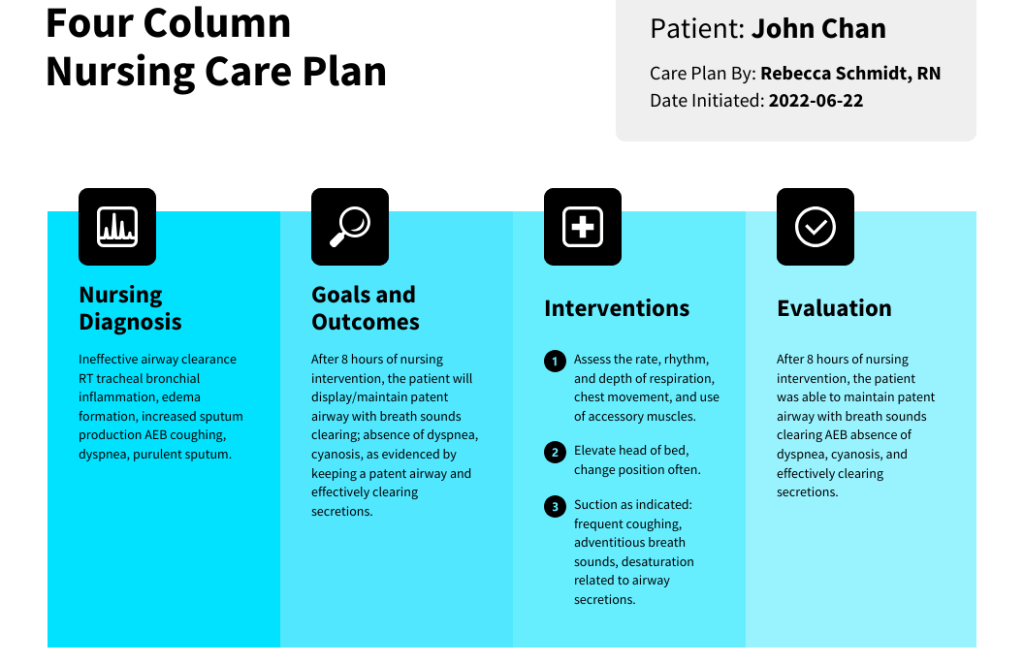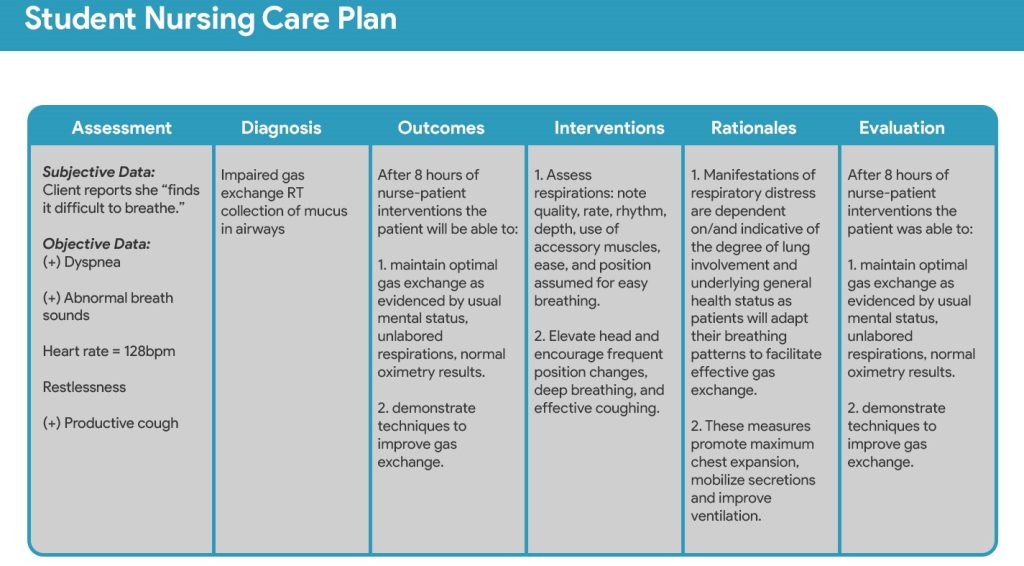
Table of Contents
The nursing care plan paper is a cornerstone of nursing education, offering a crucial opportunity to demonstrate your understanding of patient assessment, diagnosis, and intervention. It’s more than just a checklist of tasks; it’s a dynamic document that outlines your individualized approach to patient care, showcasing your critical thinking and clinical judgment.
Writing a compelling nursing care plan paper requires meticulous planning, clear communication, and a deep understanding of nursing theory and practice. This guide will equip you with the tools and knowledge needed to craft a paper that not only meets the requirements but also stands out as a testament to your nursing expertise.
What is a Nursing Care Plan?
A nursing care plan is a written document that outlines the care that a nurse will provide to a patient. It is a roadmap for the nursing team, ensuring that everyone is working together to meet the patient’s individual needs and achieve their desired outcomes.
Here’s a breakdown of its key features:
What’s included:
- Assessment: A detailed review of the patient’s health status, including their medical history, physical exam findings, and any concerns they have.
- Diagnosis: Identifying the patient’s nursing problems, often expressed as “nursing diagnoses” (e.g., impaired mobility, risk for falls, ineffective breathing pattern).
- Planning: Setting realistic and measurable goals for the patient. These goals should be specific, measurable, achievable, relevant, and time-bound (SMART).
- Interventions: Specific actions the nurse will take to address the patient’s needs and help them achieve their goals. These might include:
- Direct care: Providing medication, changing dressings, assisting with mobility, etc.
- Education: Teaching the patient about their condition, self-care, or medication administration.
- Collaboration: Working with other healthcare professionals, such as doctors or physical therapists.
- Evaluation: Regularly assessing the effectiveness of the care plan and making adjustments as needed.
Benefits of a nursing care plan:
- Improved patient outcomes: By providing a clear framework for care, nursing care plans help ensure that patients receive the most effective and individualized treatment.
- Enhanced communication: The care plan serves as a common language for all members of the healthcare team, fostering collaboration and continuity of care.
- Increased efficiency: By organizing care, the care plan helps nurses prioritize tasks and allocate resources effectively.
- Reduced risk of errors: A well-developed care plan can help minimize mistakes by providing clear guidelines for nursing interventions.
- Empowerment for patients: Patients are encouraged to participate in developing their care plan, leading to greater understanding and ownership of their health journey.
Types of nursing care plans:
- Standardized care plans: Pre-written plans that cover common health conditions or procedures.
- Individualized care plans: Developed specifically for each patient, taking into account their unique needs and goals.
- Collaborative care plans: Plans developed in partnership with the patient, their family, and other healthcare professionals.

Overall, nursing care plans are crucial for providing high-quality, safe, and effective nursing care.
Steps to Crafting a Stellar Nursing Care Plan Paper
1. Start with a Strong Foundation: The Nursing Diagnosis
A well-constructed nursing care plan paper hinges on a well-defined nursing diagnosis. This is the core of your paper, highlighting the patient’s specific health problem that requires nursing intervention. The diagnosis must be accurately formulated based on your assessment of the patient’s needs.
a. Gathering Data: Begin by meticulously collecting data about the patient. This includes their medical history, current health status, physical assessment findings, and any relevant social or environmental factors. Utilize a systematic approach, such as the Gordon’s Functional Health Patterns, to ensure a comprehensive evaluation.
b. Analyzing the Data: Analyze the gathered data to identify patterns and potential problems. Ask yourself: What are the patient’s strengths and weaknesses? What are their current needs and priorities? What are the contributing factors to their health problem? By critically examining the data, you can form a clear understanding of the patient’s condition and identify the most relevant nursing diagnosis.
c. Defining the Diagnosis: The nursing diagnosis statement should be concise and specific, capturing the essence of the patient’s problem. Utilize the NANDA-I (North American Nursing Diagnosis Association International) standardized language for accurate and consistent terminology. For example, instead of “Patient is at risk for infection,” use “Risk for Infection related to compromised immune system.” This specific diagnosis clearly identifies the patient’s vulnerability and the contributing factor.
2. Setting Realistic Goals:
Once you’ve established the nursing diagnosis, you need to formulate achievable goals for the patient. These goals should be specific, measurable, attainable, relevant, and time-bound (SMART). They must be patient-centered, reflecting their desired outcomes and aligning with their individual needs and preferences.
a. Patient Involvement: Include the patient in the goal-setting process whenever possible. This fosters a sense of ownership and commitment to the care plan. Ask questions such as, “What do you hope to achieve during your recovery?” or “What are your concerns about your current health status?”
b. Measurable Outcomes: Ensure your goals are quantifiable and measurable. For instance, instead of stating “Patient will improve breathing,” specify “Patient will demonstrate improved breathing by achieving a respiratory rate between 12 and 20 breaths per minute by the end of the shift.” This specific goal allows you to track progress and evaluate the effectiveness of your interventions.
c. Realistic Expectations: Goals should be realistic and attainable, considering the patient’s condition and individual limitations. Avoid setting overly ambitious goals that may lead to frustration or discouragement. The goal should be challenging yet achievable within a reasonable timeframe.

3. Selecting Evidence-Based Interventions:
The interventions you choose must be directly related to the nursing diagnosis and tailored to the individual patient’s needs. They should be based on current research and best practices, ensuring optimal care and safety.
a. Research-Based Interventions: Utilize credible sources, such as professional journals, textbooks, and reputable online databases, to identify evidence-based interventions for the chosen diagnosis. This demonstrates your commitment to providing high-quality, safe, and effective care.
b. Specific and Measurable: Interventions should be clearly described, outlining the specific actions you will take to achieve the stated goals. Use measurable terms such as “frequency,” “duration,” and “intensity” to ensure clarity and consistency. For example, instead of writing “Encourage deep breathing exercises,” specify “Instruct the patient to perform deep breathing exercises 10 times per hour.”
c. Collaboration and Communication: Emphasize the importance of effective communication and collaboration with other healthcare professionals. Identify the roles and responsibilities of each member of the care team, ensuring a seamless and coordinated approach to patient care.
4. Evaluating the Care Plan:
The nursing care plan paper is not a static document. It requires ongoing evaluation and adjustment to ensure effectiveness and adapt to the patient’s changing needs.
a. Monitoring Progress: Regularly monitor the patient’s progress towards their goals. Assess the effectiveness of the chosen interventions and make necessary adjustments based on your observations.
b. Documentation: Thorough and timely documentation is crucial for effective evaluation. Record the patient’s response to interventions, any changes in their condition, and any revisions made to the care plan. Use clear, concise language that is easily understood by all healthcare professionals.
c. Collaboration and Reflection: Collaborate with other members of the care team to discuss the patient’s progress and revise the care plan as needed. Reflect on your own practice and identify areas for improvement. This ongoing evaluation process ensures the care plan remains relevant and responsive to the patient’s evolving needs.
5. Writing a Compelling Nursing Care Plan Paper:
The structure and presentation of your nursing care plan paper are crucial for conveying your message effectively. Pay attention to these key aspects:
a. Clarity and Organization: The paper should be logically organized, with a clear and concise writing style. Use headings and subheadings to guide the reader through the different sections, enhancing readability and flow.
b. Evidence-Based Support: Provide evidence to support your chosen nursing diagnosis, goals, and interventions. Cite credible sources using a consistent referencing style. This demonstrates your understanding of the research and best practices that underpin your chosen approach.
c. Professionalism and Objectivity: Maintain a professional tone throughout the paper, avoiding personal opinions or biases. Present the information in a clear, objective, and concise manner, using appropriate terminology and avoiding jargon.
d. Critical Thinking and Reflection: Reflect on your own thought processes and decision-making. Analyze the rationale behind your chosen interventions and highlight the critical thinking skills that informed your nursing care plan.
6. Specific Tips for Writing a Winning Nursing Care Plan Paper:
- Focus on the patient: Remember, the nursing care plan paper is about the patient, not about you. Keep the patient’s needs and priorities at the forefront of your writing.
- Use specific examples: Illustrate your points with specific examples from the patient’s assessment, diagnosis, or interventions. This adds depth and credibility to your paper.
- Show your understanding: Demonstrate that you understand the underlying theories and concepts related to the nursing diagnosis and interventions. Connect your knowledge to the patient’s specific situation.
- Proofread carefully: Before submitting your paper, carefully proofread it for errors in grammar, spelling, and punctuation. This ensures a professional and polished presentation.
Examples of Compelling Nursing Care Plan Papers
- A Case Study of a Patient with Chronic Obstructive Pulmonary Disease (COPD): This paper could focus on a patient with COPD, outlining their assessment findings, nursing diagnosis (e.g., Impaired Gas Exchange, Ineffective Airway Clearance), specific goals, and evidence-based interventions (e.g., oxygen therapy, airway clearance techniques, education about smoking cessation).
- The Role of the Nurse in Managing Postpartum Depression: This paper could explore the complex challenges of postpartum depression, emphasizing the nurse’s role in identifying symptoms, providing support, and collaborating with other healthcare professionals.
- Addressing Pain Management in Patients with Cancer: This paper could examine the ethical and practical considerations involved in pain management for patients with cancer, showcasing the nurse’s role in advocating for patient comfort and quality of life.
Avoiding Common Pitfalls in Your Nursing Care Plan Paper
While a nursing care plan paper is an excellent opportunity to showcase your nursing knowledge and skills, it’s crucial to avoid common pitfalls that can detract from the paper’s effectiveness and professionalism. Here are some mistakes to be mindful of:
1. Neglecting the Foundation: A Weak Nursing Diagnosis
The foundation of a solid nursing care plan paper lies in a well-defined nursing diagnosis. A weak diagnosis can weaken the entire paper, leading to inaccurate goals, inappropriate interventions, and an overall lack of focus.
- Vague or Overly Broad Diagnosis: Avoid using general terms like “Patient is at risk for infection.” Instead, specify the risk factor, such as “Risk for Infection related to compromised immune system.”
- Medical Diagnosis as Nursing Diagnosis: Remember, the nursing care plan paper focuses on nursing interventions. Don’t mistake a medical diagnosis (e.g., pneumonia) for a nursing diagnosis. Instead, identify the nursing problem related to the medical diagnosis (e.g., Ineffective Airway Clearance).
- Lack of Supporting Data: Ensure your chosen diagnosis is supported by data from your patient assessment. Include specific findings that justify the diagnosis, demonstrating your critical thinking skills.

2. Unrealistic and Unmeasurable Goals
The goals you set for your patient must be realistic and measurable to track progress effectively. Ambiguous or overly ambitious goals make it difficult to evaluate the effectiveness of your interventions.
- Subjective Goals: Avoid vague goals like “Patient will feel better.” Instead, focus on measurable outcomes such as “Patient will report a decrease in pain level from 8/10 to 4/10 by the end of the shift.”
- Ignoring Patient Involvement: Include the patient in goal-setting whenever possible. This promotes patient ownership and helps ensure the goals are aligned with their individual needs and preferences.
- Unrealistic Timeframes: Set achievable timeframes for goal achievement, considering the patient’s condition and the complexity of the nursing problem.
3. Interventions Lacking Evidence and Specificity
The interventions you choose for your nursing care plan paper must be evidence-based, directly related to the nursing diagnosis, and tailored to the patient’s individual needs.
- General Interventions: Avoid vague interventions like “Encourage fluid intake.” Instead, specify the type of fluid, frequency, and target intake amount (e.g., “Encourage the patient to drink 8 glasses of water per day”).
- Lack of Rationale: Always provide a clear rationale for each intervention, explaining how it addresses the chosen nursing diagnosis and contributes to achieving the stated goals.
- Ignoring Patient Preferences: Consider the patient’s cultural background, values, and preferences when choosing interventions. Ensure they are acceptable and safe for the individual patient.
4. Inadequate Evaluation of the Nursing Care Plan
Evaluating the effectiveness of the nursing care plan is crucial. Avoid simply stating that goals were met or not met.
- Superficial Evaluation: Go beyond a simple “met” or “not met” statement. Explain how you assessed the patient’s progress, the specific data that supported your evaluation, and any adjustments made to the plan.
- Lack of Reflection: Reflect on your own practice and identify areas for improvement. Discuss challenges you encountered, lessons learned, and how you might approach the care plan differently in the future.
5. Common Formatting and Style Errors in the Nursing Care Plan Paper
A well-organized and professionally presented nursing care plan paper enhances its readability and credibility.
- Poor Organization: Ensure your paper is logically structured with clear headings and subheadings. This guides the reader through the different sections, enhancing comprehension.
- Lack of References: Always cite credible sources to support your chosen nursing diagnosis, interventions, and rationale. Use a consistent referencing style throughout the paper.
- Unprofessional Language: Maintain a professional tone throughout the paper, avoiding jargon and subjective language. Use clear, concise, and objective language that is easily understood.
While crafting a well-written nursing care plan paper requires time and effort, avoiding these common pitfalls will significantly enhance your paper’s quality and demonstrate your knowledge and skills as a proficient nurse. Remember, the nursing care plan paper is not only an assessment tool but also a valuable learning opportunity, allowing you to refine your understanding of the nursing process and the art of providing patient-centered care.
Frequently Asked Questions about Nursing Care Plan Papers
Here are some common questions students have about nursing care plan papers:
1. What is a nursing care plan paper?
A nursing care plan paper is a written document that outlines the specific care a patient will receive based on their individual needs and health status. It’s a roadmap for nurses to provide safe and effective care, addressing the patient’s physical, emotional, and psychological needs.
2. What should be included in a nursing care plan paper?
A nursing care plan paper should include the following components:
- Patient demographics: Name, age, gender, medical history, allergies, and any other relevant information.
- Assessment data: Subjective and objective data gathered from the patient, including vital signs, physical assessment, and patient reports.
- Nursing diagnoses: Identification of patient problems that are within the scope of nursing practice.
- Goals: Specific, measurable, achievable, realistic, and time-bound objectives for the patient.
- Interventions: Nursing actions to achieve the stated goals, including medications, treatments, and education.
- Evaluation: Ongoing assessment of the effectiveness of interventions and adjustments made to the nursing care plan paper as needed.
3. How can I write a good nursing care plan paper?
Here are some tips for writing a strong nursing care plan paper:
- Focus on the patient’s needs: The nursing care plan paper should be tailored to the individual patient and their specific health concerns.
- Use clear and concise language: Avoid jargon and technical terms that the patient may not understand.
- Include specific examples: Illustrate the interventions with concrete examples of how they will be implemented.
- Be realistic: Ensure that the goals and interventions are achievable within the context of the patient’s situation.
- Be organized and structured: Use a logical format and headings to make the nursing care plan paper easy to read and understand.
4. Where can I find resources for writing a nursing care plan paper?
There are many resources available to help you with writing a nursing care plan paper. Here are a few suggestions:
- Your nursing textbook: Many textbooks contain examples of nursing care plan papers and templates to help you structure your writing.
- Online databases: Search for nursing care plan examples and templates on websites such as the National League for Nursing (NLN) and the American Nurses Association (ANA).
- Your instructor: Ask your instructor for guidance on the specific requirements for your nursing care plan paper and for any available resources.
Writing a strong nursing care plan paper requires careful planning, research, and attention to detail. By following these tips, you can create a comprehensive and effective care plan that promotes the well-being of your patients.

Final Thoughts
Writing a compelling nursing care plan paper requires a deep understanding of the nursing process, a commitment to evidence-based practice, and a dedication to providing patient-centered care. By carefully crafting each section of the paper, incorporating evidence-based interventions, and focusing on the patient’s individual needs, you can create a document that not only fulfills the requirements but also demonstrates your knowledge and skills as a competent and compassionate nurse.
The nursing care plan paper is a valuable learning tool, allowing you to apply your knowledge and hone your critical thinking abilities. By focusing on clarity, organization, and evidence-based practice, you can create a paper that stands out as a testament to your dedication to patient care and your passion for the nursing profession.
Get Professional Help with Your Nursing Care Plan Paper
Crafting an authentic and engaging nursing care plan paper may still be daunting even with the resources provided above. However, you can easily avoid all that with professional nursing paper writing help from Nursing Papers. We offer customized assistance in writing nursing research papers, essays, case studies and dissertations. Our service covers topic suggestion, paper writing, proofreading, formatting and plagiarism removal.







